The next-gen MacBook Pro with Retina Display Review
by Anand Lal Shimpi on June 23, 2012 4:14 AM EST- Posted in
- Mac
- Apple
- MacBook Pro
- Laptops
- Notebooks
Last year when I wrote about the new MacBook Airs I offered two forward looking paragraphs:
What happens from here on out is what's really interesting. Intel has already committed to moving the TDP of its mainstream parts from 35W - 45W down to 10 - 20W. Since the Air is the new mainstream Mac notebook, Apple has already made that move. The performance in this 10 - 20W segment is going to get much better over the next two years, particularly once Haswell arrives.
The Thunderbolt Display is the first sign of what's to come. Moving IO controllers and expansion into the display, and potentially even moving discrete GPUs out of the notebook are all in store for us. Apple is really ahead of the curve here, but it's easy to imagine a future where laptops become a lot more like the new Air and shift to a couple high bandwidth ports instead of numerous lower bandwidth connections.
Perhaps I was being too aggressive in the prediction of a couple of high bandwidth ports. After all, the next-generation MacBook Pro with Retina Display features four such IO ports (2 x Thunderbolt and 2 x USB 3.0). But you get my point. Gigabit Ethernet and Firewire 800 are both gone. The discrete GPU is still present but I suspect even its days are numbered, at least inside the chassis. The personal computer as we knew it for so long, is changing.
The personal computer is getting thinner, lighter, more integrated and more appliance-like. The movement is no longer confined to just Apple either. The traditional PC OEMs are following suit. Even Microsoft has finally entered the PC hardware business, something it threatened to do for years but hadn't until now. Distribution models will change, the lines between different form factors will continue to blur. What was once a mature industry is going through a significant transformation. It’s exciting but at the same time it makes me uneasy. When I first got into this industry everyone had stories of companies with great ideas that just didn’t make it. As we go through this revolution in computing I’m beginning to see, first hand, the very same.
Apple makes the bulk of its revenue from devices that don’t look like traditional personal computers. For the past couple of years I’ve been worried that it would wake up and decide the traditional Mac is a burden, and it should instead be in the business of strictly selling consumer devices. With its announcements two weeks ago in San Francisco, I can happily say that my fears haven’t come true. At least not yet.
It’s been a while since Apple did a really exciting MacBook Pro launch. Much to my surprise, even the move to Sandy Bridge, the first quad-core in a MacBook Pro, was done without even whispers of a press conference. Apple threw up the new products on its online store, shipped inventory to its retail outlets, updated the website and called it a day. Every iPhone and iPad announcement however was accompanied with much fanfare. The MacBook Pro seemed almost forgotten.
With its WWDC unveil however Apple took something that it had resigned to unexciting, dare I say uncool status, and made a huge deal about it. Two weeks ago Apple did the expected and offered relatively modest upgrades to all of its portable Macs, all while introducing something bold.
Apple calls it the MacBook Pro with Retina Display. You’ll see me refer to it as the next-gen MacBook Pro, Retina MacBook Pro, rMBP or some other permutation of these words.
After using it for the past two weeks I can honestly say it’s the best Mac Apple has ever built. And there’s a lot more to it than hardware.
Portability
If you were hoping for a 15-inch MacBook Air, that’s not what the rMBP is. Instead it is a far more portable 15-inch MacBook Pro. I have to admit I was a bit let down the first time I laid eyes on the next-gen MacBook Pro, it looks good but it doesn’t look all that different. The disappointment quickly faded as I actually picked up the machine and started carrying it around. It’s not ultra light, but man does it make the previous chassis feel dated.
While I never really liked lugging around the old MBP (and it always made me feel like the old fogey at tradeshows where everyone else had something 13-inches or smaller), carrying the rMBP is a pleasure by comparison. Pictures really don’t do it justice. The impressively thin display assembly or overall chassis thickness look neat in a photo but it’s not until you actually live with the rMBP that you can appreciate what Apple has done here. I carry around a 15-inch MacBook Pro because it’s my desktop, and as such it’s incredibly useful to have with me when I travel. For my personal usage model, the Retina MacBook Pro is perfect.
If your workload demands that you need the performance of a MacBook Pro and your lifestyle requires you to carry it around a lot, the reduction in thickness and weight alone will be worth the upgrade to the rMBP. If you spend most of your time stationary however, you’ll have to be sold on the display and internal characteristics alone. The bad news is if the design doesn’t get you, everything else will.

From left to right: 11-inch MacBook Air, 13-inch MacBook Air, 15-inch MacBook Pro, MacBook Pro with Retina Display
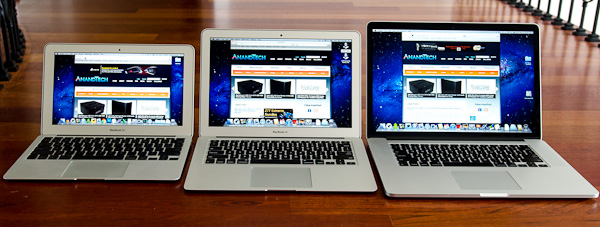
From left to right: 11-inch MacBook Air, 13-inch MacBook Air, MacBook Pro with Retina Display
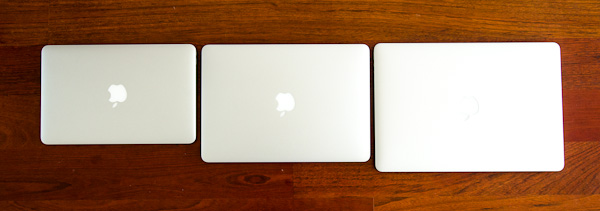
From left to right: 11-inch MacBook Air, 13-inch MacBook Air, MacBook Pro with Retina Display


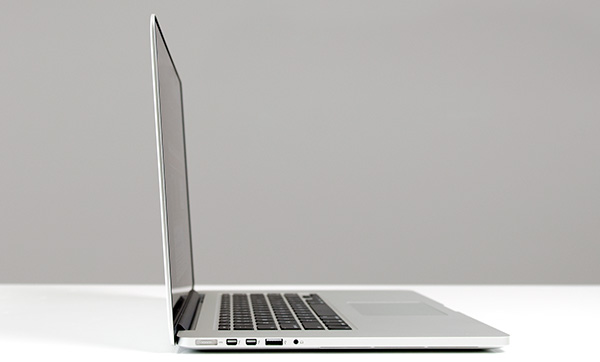
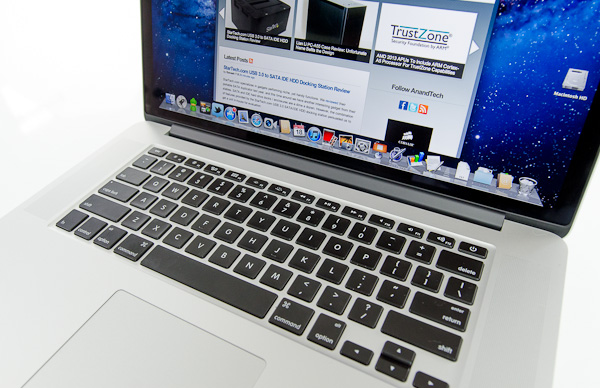
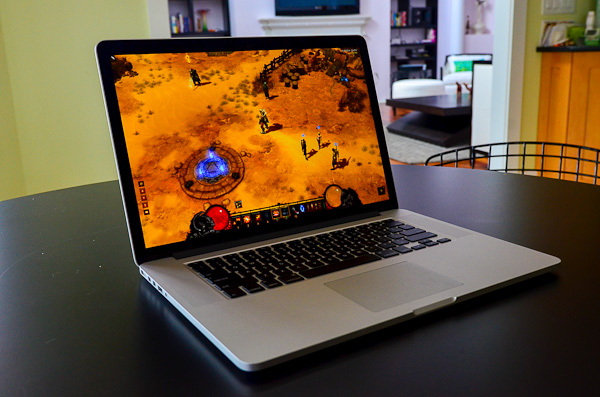
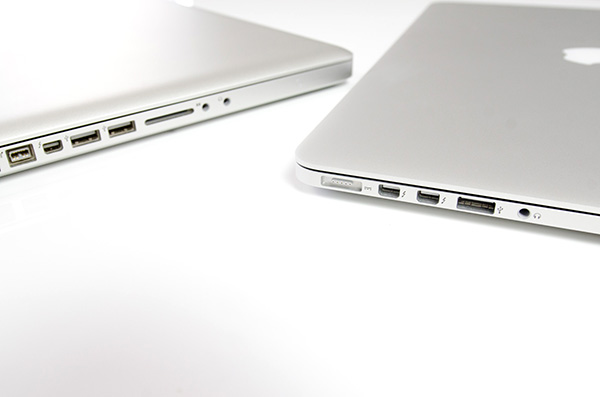
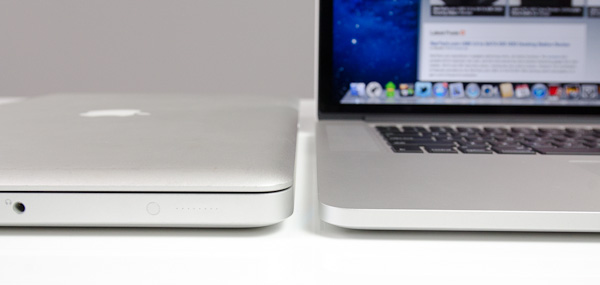








471 Comments
View All Comments
parlour - Saturday, June 23, 2012 - link
Hihi, that’s funny. I found the keyboard massively preferable to that of the non-Retina MBP. It seems tighter to me.I think the conclusion of this is that you have to try the keyboard before you buy. It’s certainly a high-quality keyboard either way, so calling it “the weakest part” is pretty much nonsense. It may be the weakest part for you personally, but not for everyone.
zappb - Saturday, June 23, 2012 - link
I said "squishy" , you said "tighter", are we still talking about a keyboard? is this another marketing thing a la retina?(tm)parlour - Saturday, June 23, 2012 - link
The old MBP keyboard feels more spongy to me while the rMBP keyboard feels tighter (or less spongy) to me. Hey, this is all hard to describe, we are all using strange words.So, no. I do not share your impression.
Omid.M - Sunday, June 24, 2012 - link
The key travel is maybe 30% less travel than the regular MBP. It's just like the Air and I can't stand it. You have to change HOW you type, unfortunately because there's little bounce back.I'm also disappointed in the GPU. There's definitely lag. I think we have to wait until Broadwell—2014 WWDC?—to see a 3rd gen rMBP that's truly polished.
The OWC video is totally misleading; there's no way the experience is smooth with 3 displays (4 total including the laptop).
gorash - Saturday, June 23, 2012 - link
Sounds like yet another overhyped Apple product (screen). "The screen is life-changing! It has changed my life! I can't look at any other screen in the same way now! Now I am more productive, I have more friends, and I've lost 20 pounds, thanks to the amazing Retina Display!". It was the same with the iPad 3. People were overhyping the Retina display, and everybody was saying how amazing and gorgeous and groundbreaking and life-changing the Retina display was. Then I actually saw it and I was like "Yeah it looks a little sharper, but it's nothing groundbreaking or anything".So yet again, people are getting overly hyped about yet another Apple product. Sure it may be a good product, but people act like it's the second coming or something... lol.
lukarak - Saturday, June 23, 2012 - link
For me, it's not the sharpness, it's the ability to use multiple 'resolutions' (non-native) viably, which provide different levels of screen realestate. I like that part of the equation much better than the increased sharpness, but i guess some people will also have use for it too.KoolAidMan1 - Saturday, June 23, 2012 - link
On top of increased sharpness, the color and contrast is the best I've seen on any laptop. It honestly competes with some of the best IPS desktop monitors I've seen. Fire up Aperture, it is pretty remarkable.The thing is a godsend for photographers and other professionals who work with images.
lukarak - Saturday, June 23, 2012 - link
I use macs for software development, so i don't really care about that, but it is still nice to have a better quality screen, sure.DeciusStrabo - Saturday, June 23, 2012 - link
The Thinkpad T530/W530 1080p is arguably better outside of the resolution - not IPS, but very near the same quality. And it has a 95 % sRGB gamut.inplainview - Saturday, June 23, 2012 - link
Here's and idea for you... Don't buy one.... Now isn't that revolutionary?